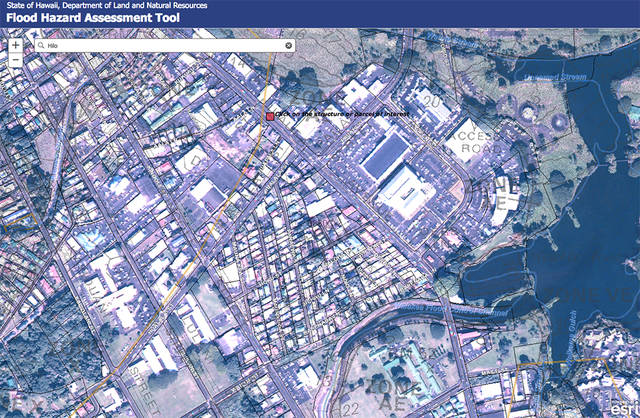Hawaii County’s updated flood zone maps are now available after a yearslong revision effort by the Federal Emergency Management Agency. ADVERTISING Hawaii County’s updated flood zone maps are now available after a yearslong revision effort by the Federal Emergency Management
Hawaii County’s updated flood zone maps are now available after a yearslong revision effort by the Federal Emergency Management Agency.
The new maps are used to set rates for flood insurance and will go into effect Sept. 29.
FEMA representatives as well as officials from the state Department of Land and Natural Resources will discuss the maps’ impact during public meetings this week in Hilo and Kailua-Kona.
The Hilo meeting is Wednesday in the Aupuni Center Conference Room, 101 Pauahi St., Suite 1. Kona’s meeting takes place Thursday at the West Hawaii Civic Center Community Meeting Hale, Building G, 74-5044 Ane Keohokalole Highway.
Both sessions are from 5-8 p.m. Two short presentations begin at 5:30 p.m. and 7 p.m., but the meetings are intended to have an open house format.
“We’re encouraging all to take a look at the maps beforehand, and not to wait until the last day or month,” said FEMA Region 9 engineer Eric Simmons. Region 9 covers Hawaii, California, Arizona and Nevada.
Simmons and his team have been
working on the project for almost 10 years, using new engineering analysis and topographic data.
Coastal areas as well as gulches and washes were surveyed.
Although agencies such as Hawaii County Civil Defense monitor flood-prone areas, the flood maps themselves are prepared mainly for insurance purposes. Property owners whose buildings are mapped in a FEMA-labeled “high-risk” area are required to have flood insurance.
The high-risk designation is “important for a couple of reasons,” Simmons said. “It is used to set insurance rates, but for the average citizen it’s probably more of a risk awareness tool.”
Some stream areas — portions of the South Kona Watercourse, Alenaio Stream and the Holualoa and Waiaha tributaries — were analyzed for the first time to determine flood risks.
In East Hawaii, parts of Waiakea Uka (the intersection of Ainaola and Haihai) and Puna were added to the higher-risk areas. In West Hawaii, Kailua Village and the Captain Cook watercourse were added.
Maps are located online at http://gis.hawaiinfip.org/fhat as well as in the Hawaii County Department of Public Works Engineering offices in Hilo and Kona.
High-risk areas are labeled beginning with letters A or V.
Hawaii County participates in the National Flood Insurance Program, which makes it eligible for federal disaster aid should a federally declared natural disaster occur. Using the FEMA-prepared maps is required to maintain that eligibility.
“The risk of flood loss is real, and there’s options for property owners to take to reduce that risk,” Simmons said.
A spokesman for the county Department of Public Works said the department was encouraging people to find out their risk status, and if it changed, to purchase flood insurance before Sept. 29.
People who buy flood insurance before the maps go into effect — and before flood insurance rates change — can be grandfathered in to a lower premium rate, according to a FEMA informational sheet.
Email Ivy Ashe at iashe@hawaiitribune-herald.com.



